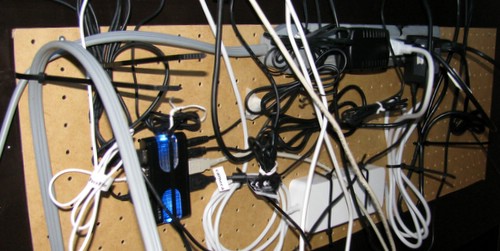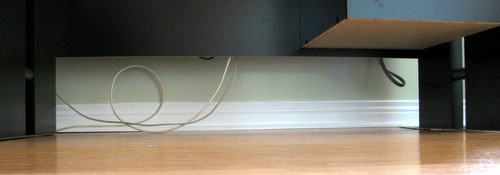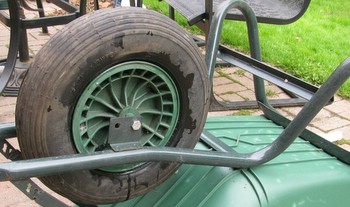This is something I actually did back in February when we moved our computer room to make room for our new arrival. This is one of those DIY tasks that doesn’t take very long to do (a couple of hours tops), but you can put it off for ages (sort of like writing this post). Anyone dealing with a rats nest of cables behind / below their desk, maybe this will serve as a kick in the pants to do something about it.
The LifeHacker article inspired me, but clearly not enough to quickly leap on the idea and deal with my mess of cables. They actually have a whole category dedicated to cable management which is worth a browse if you are looking for ideas. The original concept came from a site which seems to be gone now, but can still be seen via the Way Back Machine.
 So pictured above is my version of the peg board cable organizer. I’ve got a 2′ x 4′ peg board mounted on the back of the desk (between the desk and the wall). There are only 2 screws holding the board to the desk (upper left and right corners). I’ve used a couple of washers between the peg board and the desk to give it a bit of room for the cable ties. Everything is zip-tied to the board, power bar included. Since I’ve only got 2 screws at the top, I can bend the board (gently) away from the desk to get easy access to the back side to help route the zip ties.
So pictured above is my version of the peg board cable organizer. I’ve got a 2′ x 4′ peg board mounted on the back of the desk (between the desk and the wall). There are only 2 screws holding the board to the desk (upper left and right corners). I’ve used a couple of washers between the peg board and the desk to give it a bit of room for the cable ties. Everything is zip-tied to the board, power bar included. Since I’ve only got 2 screws at the top, I can bend the board (gently) away from the desk to get easy access to the back side to help route the zip ties.
 The view from the front of the desk is what makes this worth doing. No clutter on the floor (ok, an errant ethernet cable and the USB to the printer). Even for my desk (pictured is Jenn’s) – where I need to plug and unplug things like my laptop regularly, this setup works well. I simply mounted the powerbar near the top of the peg board and that places the outlets near enough to the top of the back edge of the desk that its not a problem.
The view from the front of the desk is what makes this worth doing. No clutter on the floor (ok, an errant ethernet cable and the USB to the printer). Even for my desk (pictured is Jenn’s) – where I need to plug and unplug things like my laptop regularly, this setup works well. I simply mounted the powerbar near the top of the peg board and that places the outlets near enough to the top of the back edge of the desk that its not a problem.
This project only took a couple of hours, it is very functional – and tidy too. What are you waiting for?

